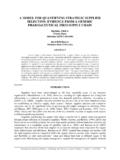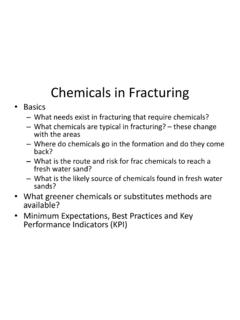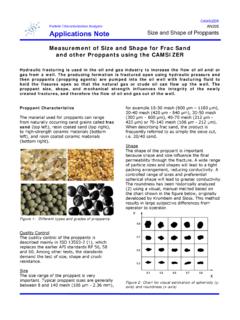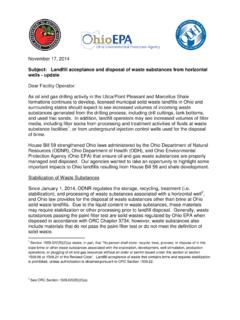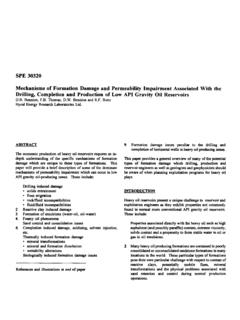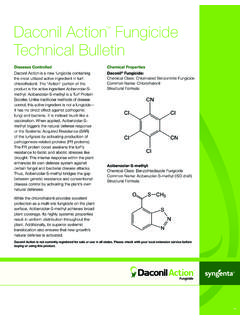Transcription of ABRASION RESISTANT STEEL PIPING SYSTEMS …
1 April 30, 1999 Page 1 of 1 ABRASION RESISTANT STEEL PIPING SYSTEMS FOR SLURRY TRANSPORT IN MINING APPLICATIONS Robert E. Klemm, UltraTech, Port Washington, WI 53074-308 USA ABSTRACT Various metallurgical and material enhancements are available to transform STEEL pipe into high strength, ABRASION RESISTANT products, suitable for the transport of abrasive slurries encountered in mining applications.
2 These enhancements include induction hardening of the interior pipe wall, in addition to utilizing pipe wall materials consisting of varying chemistries, such as encountered with bi-metallic, di-clad, and double wall PIPING SYSTEMS . Each type of system has advantages and disadvantages, both in the manufacturing processes as well as in their application for slurry transport of abrasive materials. The proper selection of component accessories, including the various configurations and alternate materials can provide the ultimate total system wear life expectancy. Section 1 Typical Mine Applications STEEL PIPING SYSTEMS are widely used in mining to convey the product, ore, and tailing slurries to the processing plant, as well as to recycle the debris medium back to the mining area.
3 Slurries are a mixture of solid particles in a liquid medium. STEEL PIPING SYSTEMS are also utilized for backfilling the mine excavation areas utilizing sand fill, classified tailings, or paste fill. STEEL PIPING SYSTEMS are also widely utilized as drop shafts for conveying product from high elevations. Section 2 Types of Wear Unfortunately, the conveying of mineral products often causes the PIPING SYSTEMS to wear. Wear is defined as the gradual and progressive loss of material due to the relative motion between the conveying medium and the pipe. There are two basic ways material is removed from the surface: the material can be dissolved through a chemical reaction, or material can be mechanically fractured from the surface. This paper will address the mechanical interaction between the slurry particles and the PIPING system .
4 Abrasive wear is produced by hard particles forced against and sliding along the wall of the pipe. The loss of material is the result of the hard, sharp angular edges producing a cutting or shearing action on the pipe wall. In abrasive erosion the loss of material is due to the relative motion between the pipe wall and a fluid containing solid particles. The magnitude of April 30, 1999 Page 2 of 2 wear depends on the angle of impingement and the type of material being eroded.
5 At close to 90 degree impingement angles (impact ABRASION ), the erosive wear rate is highest in brittle materials and lowest in ductile materials. In ductile materials, the repeated impinging particles plastically deform the surface to generate wear debris. With brittle materials, the impingement causes particles of material to be fractured as wear debris. Brittle materials are less wear RESISTANT than ductile materials in an impact erosion condition. At low angles of impingement (abrasive erosion), the reverse is the case. Harder materials better resist the gouging or plowing action of abrasive particle flow. Section 3 Hardness Hardness can be defined as the resistance to penetration. Early methods used to measure hardness consisted of comparing a known object to an unknown.
6 A scratch test would indicate whether one element is harder than the other. The scratch test is still utilized today in the Moh s scale (see the Relative Material Hardness chart below). The hardest material known to man is the diamond, which was assigned a value of 10. All other materials were rated relative to the diamond hardness. April 30, 1999 Page 3 of 3 Current hardness measurement technology utilizes an indenter of a specific configuration with an applied load of known value.
7 The softer the material, the larger the diameter and the deeper the indentation. By measuring either the depth of penetration (the Rockwell Scale) or the diameter of the indentation (the Brinell Scale), the hardness of a given object can be determined. These are the two most common field measurement SYSTEMS . Additionally, the Knoop or Vickers hardness system is often utilized in laboratory environments for measurement of very hard materials, such as carbides. There is an approximate relationship between hardness and the ultimate strength of the material (see table below). As expected, for abrasive wear, the amount of wear decreases as the strength/hardness of the PIPING material increases. To resist ABRASION , the PIPING system must be harder than the material being conveyed.
8 Selecting a pipe material considerably harder than the conveyed material offers no wear advantage and typically costs more. The wear rates of various PIPING materials are often similar, so long as their hardness is greater than the material slurry. For instance, if the material being transported is limestone, there is no advantage in using ceramic lined pipe over an ordinary STEEL pipe. When the mineral is harder than the pipe, there is a very sudden and steep rise in the abrasive wear rate. 600 Brinell = Rockwell C 309,000 psi Tensile Strength 400 Brinell = Rockwell C 202,000 psi Tensile Strength 200 Brinell = ( Rockwell C 98,000 psi Tensile Strength 111 Brinell = - - - - 55,000 psi Tensile Strength Section 4 PIPING Materials Fortunately, today there are a wide variety of PIPING materials available to optimize system performance.)
9 These PIPING SYSTEMS range from the simple high strength low-alloy steels to the latest in bimetallic and metallurgically bonded materials. By considering these materials with the appropriate system design parameters and PIPING configurations, system performance can be significantly enhanced. Material enhancements take three different approaches: 1) material alloying, 2) modifying the material microstructure (cold working, hardening, etc) or 3) composite materials. April 30.
10 1999 Page 4 of 4 Material Alloying Strength and wear resistance can be improved by the addition of alloying elements to the STEEL during the manufacturing process. Typically the addition of higher levels of carbon and manganese increases the ultimate strength over mild STEEL by 70 percent, from 55,000-psi ultimate strength to the 90-100,000 psi range, and increases the as rolled hardness to 200 Brinell. This improves the wear resistance by as much as 20 %. This material is commonly referred to as AR200 PIPING .






